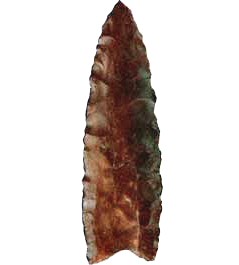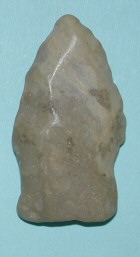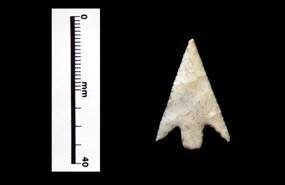Today, my adoring public, I’m going to talk about something near and dear to my heart: North Texas archeology. I’m not quite an expert, but I worked in the area for nigh on ten years back when I dug holes and played in the dirt for a living. The Dallas/Fort Worth area has yielded some significant finds dating back to at least 13,000 years ago, and there are some excellent collections of those remains in local public repositories, particularly the Dallas Museum of Natural History and the Fort Worth Museum of Science and History (both of which are overdue for a blog entry). I expect you’ll enjoy browsing both when you come to visit. To help you better understand what you’ll see, I’ve prepared this little introduction to the basics of D/FW prehistory. It’s not nearly as detailed as what you might find in, say, a thesis or a textbook, but I think it gets the basic points across.
The Very First Americans
For years, researchers believed that the First Americans belonged to the Clovis culture. Not so! Given some groundbreaking work that Mike Waters (my committee head at Texas A&M) recently published in Science, we now know for certain that the Clovis people couldn’t have been first. The maximum age of the earliest Clovis sites in North America is about 13,250 years, and some of the cultural remains we’ve found are older than that, so Q.E.D.
It’s hard to say, however, whether there were any pre-Clovis people in the D/FW area or not. The Trinity River would have made the region attractive to any group of nomads, but most of the environments where they would have lived have either been destroyed by erosion or are very deeply buried, and their remains would have been scanty in any case. Searching for demonstrably pre-Clovis remains is the region is going to be a tough job, one that awaits the development of a lot of new techniques and technology.
Paleo-Indian Period (13,500-8,000 Years Ago)
The Paleo-Indians were the first humans to colonize North Texas in force, arriving approximately 13,000 ago, probably in search of big game animals like mammoth and bison. As big game hunters, they left behind very distinctive cultural remains, and are best known for their stone projectile points. Most types had channels taken out of each side and/or well-grounded bases, so that they could be strapped safely to dart shafts. The Clovis, Folsom, Angostura, and Plainview cultures characterize this period in Texas. Paleo-Indian cultures tended to be extremely widespread; Clovis sites have been found all over the North American continent, from southern Canada to northern Mexico, while Folsom is limited to the Great Plains region, which stretches from Canada down into South Texas. The picture below displays a typical Clovis point; it’s maybe three inches long.

Archaic Period (8,000-5,000 Years Ago)
As big game become increasingly scarce due to mass extinctions at the end of Pleistocene (possibly caused by over-hunting), subsistence strategies shifted toward lifeways less dependent on large game for survival, and the Paleo-Indian peoples began to diversify into a series of regional cultures that have collectively come to be known as “Archaic.” For North and Central Texas, this period has been further divided into Early, Middle, and Late Archaic periods. The Early Archaic appears to be at least in part transitional between the Paleo-Indian and actual Archaic periods. Population densities were low during this period, and groups were organized into small, mobile bands. Diagnostic lithic (stone) tool types for the Early Archaic include large spear and dart points such as the Martindale, Bell, and Bulverde types, and Clear Fork wood-working tools.
The Middle Archaic (5,000-3,000 Years Ago) is usually subdivided into early (Clear Fork) and late (Round Rock) intervals. Nolan and Travis dart points are considered to be the diagnostic markers for the Clear Fork interval, while Langtry, Marshall, and Pedernales projectile points are diagnostic Round Rock components. The Middle Archaic in general is characterized by the first appearance of burned rock middens in North and Central Texas. These thick piles of fire-cracked rock (usually limestone) may represent the material remains of plant food processing — particularly of acorns and onion-like tubers called camas, both of which required a lot of heating and cleaning before they were edible. In addition, the large number of sites known for this period may indicate an increase in the regional population density.
The Late Archaic (3,000-1,200 Years Ago) is generally subdivided into the San Marcos (early) and Twin Sisters (late) intervals. The San Marcos phase, which is characterized by such triangular projectile point types as Montell, Marcos, and Castroville, probably represents a smaller, more mobile population with a less-specialized economy than that of the Middle Archaic, geared, perhaps, toward bison hunting. Another characteristic lithic product of this period was the widely-traded corner-tang biface, specimens of which have been found as far away as the Great Plains and the American Midwest.
The Twin Sisters phase is characterized by a decrease in the size of projectile point styles, as typified by the Ensor, Frio, Darl, and Fairland varieties. They were still dart and spear points, but they were headed toward the arrow points that were soon to come. Researchers don’t agree on exactly what these folks ate, although it appears that burned rock midden accumulation may have slowed or ceased during this period. Increases in population in the D/FW area region and decreases in population on the Edwards Plateau (around Austin) may indicate a settlement shift. The point in the picture below is a typical Late Archaic point (of un unidentified type, sadly), though admittedly it comes from the beaches Padre Island rather than D/FW. Note how well polished it is. It’s about twice as long as a penny, and just a bit wider.

Late Prehistoric Period (1,200-400 Years Ago)
The Late Prehistoric period is marked by the adoption of the bow and arrow as weapon of choice among Central Texas groups. This period is split into two generally accepted intervals, Austin (early) and Toyah (late). The lithic tool culture of this period is dominated by tiny arrowheads of the kind that most collectors call “bird points.” In fact, these were made to fit a standard arrow, and were used to hunt deer, bison, and other animals. If they were used to kill birds at all, it was as an afterthought. The big, chunky points that collectors refer to as “arrowheads” are actually the dart and spear points that were used by pre-bow and arrow cultures.
The Austin interval dates approximately 1,200-700 years ago. During this phase, the human population of North Texas seemed to decline. The Austin phase is distinguished by expanding-stem arrow points such as Scallorn points. The following Toyah interval is characterized by rapid technological change, the introduction of ceramic pottery, and changes in subsistence. Bison again became an important food source. Artifact inventories increased, and a variety of contracting-stem arrow points known as Perdiz points were developed (that’s one in the picture below). There’s evidence that a limited amount of agriculture was practiced during this period, although some research indicates that the Toyah economy focused on bison hunting. Deer hunting was probably also important.

Historic Period (400 Years Ago-present)
You probably know a lot about this one from the white perspective, so I’m not going to go into Euro-American cultural history here; let’s stick to the Native Americans. By the beginning of the Historic period, some Native Americans were practicing horticulture; we know this because the Spanish, the first Europeans to enter Texas in significant numbers in the 16th century, recorded quite a bit about the natives before they wiped them out through disease and warfare. Attempts have been made to connect historic Indian groups with the Toyah phase of the Late Prehistoric period, but none have proved convincing. Even though the Spanish left Texas for a couple of hundred years after that, they still had a huge impact on the peoples who survived. Spanish contact in the Great Plains in the early 1600’s also reintroduced the horse into North America, where it had been extinct for approximately 11,000 years. This animal rapidly changed the lifeways of many Indian groups, producing <> highly mobile bands such as the Apache and Comanche who moved into Texas and pushed out many of the native peoples who had survived the European advance. Most of the rest were forced out when the Mexican inheritors of Spanish Texas let white Americans get a foothold in Texas in the early 1820s. Today, most of the remaining Native Americans in Texas are concentrated on a few small reservations, and most of those groups aren’t even native to Texas.
And In Conclusion…
I hope you’ve enjoyed this pocket guide to North Texas archeology. The idea was to give you some background against which to understand any archeology you might encounter when you’re visiting our fine public establishments, or working with local archeological societies, or even volunteering on a dig. I’ll be adding more blog entries to the Archeology series on a regular basis, so keep an eye out. Expect to see something on the Dallas Museum of Natural History and the Dallas Archeological Society soon. If I can, I’ll also dig up some info on where you can buy some replicated spear and arrow points, if you like; there are a lot of talented artisans out there.
